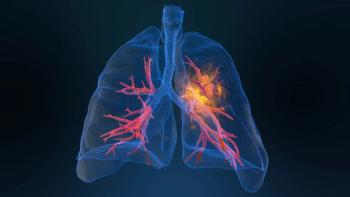
Oncology NEWS International
- Oncology NEWS International Vol 10 No 10
- Volume 10
- Issue 10
Predicting NSCLC Outcomes
SAN FRANCISCO-The biologic marker matrix metalloproteinase-9 (MMP-9) has been identified as an important new predictor of disease recurrence and poor outcome in non-small-cell lung cancer (NSCLC). It also offers some insight into the mechanisms by which NSCLC tumors grow and spread.
SAN FRANCISCOThe biologic marker matrix metalloproteinase-9 (MMP-9) has been identified as an important new predictor of disease recurrence and poor outcome in non-small-cell lung cancer (NSCLC). It also offers some insight into the mechanisms by which NSCLC tumors grow and spread.
Eckart Laack, MD, of the University Hospital Hamburg-Eppendorf, Hamburg, Germany, reported the results at the 37th Annual Meeting of the American Society of Clinical Oncology (ASCO abstract 1645). The study involved 118 NSCLC patients (50 with stage I/II disease, 27 with stage IIIA/B disease, and 41 with stage IV disease).
The investigators measured pretreatment serum levels of two factors, both of which play an important role in the angiogenic process: (1) MMP-9, which degrades basement membrane type IV collagen, allowing angiogenesis and, by implication, tumor invasion and metastasis, and (2) vascular endothelial growth factor (VEGF), the most potent growth factor and a positive regulator of angiogenesis in a majority of malignancies.
The study showed that serum levels of MMP-9 were significantly correlated with tumor stage. Patients with early disease had a median MMP-9 level of 910 ng/mL, compared with 1,340 ng/mL for those with locally advanced disease and 1,796 ng/mL for those with metastatic disease (P = .005).
Patients who died during the first year had significantly higher pretreatment levels of MMP-9 (1,796 ng/mL) than those who survived 1 year (989 ng/mL, P = .0005).
The median serum level for MMP-9 for all patients was 1,293 ng/mL. Levels of MMP-9 in excess of 2,300 ng/mL carried a very poor prognostic indication, Dr. Laack said. These patients had a median survival of 278 days vs 587 days for those with levels less than 1,200 ng/mL.
Besides performance status, the only independent prognostic factor in multivariate analysis was the pretreatment serum level of MMP-9. Stage, histologic type, sex, age, and lactate dehydrogenase, hemoglobin, and VEGF levels had no effect on survival.
Although VEGF expression was not associated with survival, it was positively correlated with tumor stage and with MMP-9 expression (P = .0005).
There was also a significant correlation between elevated serum platelet levels and MMP-9 and VEGF expression. "The role of platelets is unknown," Dr. Laack said. "Platelets may play a more positive role in storage or as a carrier, rather than in actually producing angiogenic factors."
Additionally, in a subgroup of 72 patients who underwent surgery, elevated serum levels of MMP-9 were significantly correlated with the occurrence of metastases and local relapse (P = .037).
Articles in this issue
about 24 years ago
High-Dose IL-2 Is Standard in Advanced Renal Cell Cancerabout 24 years ago
RIT Safe, Effective in Elderly and Poor-Prognosis Patientsabout 24 years ago
FDA Approves Xeloda/Taxotere Combination for Advanced Breast Cancerabout 24 years ago
ODAC Recommends Approval of Radiolabeled Zevalinabout 24 years ago
Proteomics Moves From the Laboratory to Clinical Researchabout 24 years ago
Radiotherapy Not Needed in Older Lumpectomy Patients With Early Cancerabout 24 years ago
Raltitrexed + Oxaliplatin for Advanced Colorectal Cancerabout 24 years ago
Mental Fatigue Worries Chemotherapy Patientsabout 24 years ago
Patients Urged to Work With Professionals Against Fatigueabout 24 years ago
NCI Director Resigns to Head New Scientific InstituteNewsletter
Stay up to date on recent advances in the multidisciplinary approach to cancer.













































































